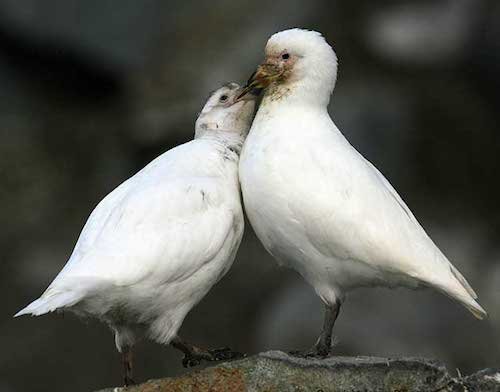Chionidae – Sheathbill

The Chionididae or sheathbills are a family of birds in the wader order Charadriiformes, the family contains one genus, Chionis, with only two species. They breed on subantarctic islands and the Antarctic Peninsula, and the snowy sheathbill migrates to the Falkland Islands and coastal southern South America in the southern winter; they are the only bird family endemic as breeders to the Antarctic region. They are also the only Antarctic birds without webbed feet.
They have white plumage including a thick layer of down, with only the face and leg colours distinguishing the two species. They look plump and dove-like, but are believed to be similar to the ancestors of the modern gulls and terns. There is a rudimentary spur on the carpal joint, as in plovers. The skin around the eye is bare, as is the skin above the bill, which has carbuncular swellings. They derive their English name from the horny sheath which partially covers the upper mandible of their stout bills. They are commonly known in the Antarctic as ‘Mutts’ because of their call which is a soft ‘Mutt, mutt, mutt’.
They habitually walk on the ground, somewhat like rails. They fly only when alarmed or in migration, looking like pigeons and are opportunistic feeders, consuming invertebrates, faeces, and carrion, including seal afterbirths and stillborn seal pups, between the tidelines. They also take chicks and eggs from cormorants or penguins.
During the penguin breeding season, which is also their own breeding season, pairs of sheathbills establish territories in penguin colonies covering a number of penguin nests. Two mated sheathbills often work together to harass adult penguins, nimbly avoiding their attempts to peck; they gain access to the eggs or chicks or steal the krill that the adult penguins regurgitate to feed their chicks. Near the few human settlements of the region, they boldly forage for offal. Because of this diet, they spend a good deal of time cleaning themselves.
They lay 2 or 3 blotchy white eggs in crevices or rock cavities.[2] The nests are lined messily with seaweed, stones, feathers, guano, bones, and occasionally plastic trash; even dead chicks may not be removed. Incubation lasts 28 to 32 days, and the young fledge 50 to 60 days later.
According to the IOC, there are just two species in the family Chionidae; which are:
Snowy Sheathbill Chionis alba
Black-faced Sheathbill Chionis minor
Snowy Sheathbill is monotypic but the Black-faced Sheathbill has four recognised subspecies:
C. m. marionensis Reichenow, 1908 – Prince Edward and Marion Is.
C. m. crozettensis (Sharpe, 1896) – Western Black-faced Sheathbill – Crozet Is.
C. m. minor Hartlaub, 1841 – Eastern Black-faced Sheathbill – Kerguelen Is.
C. m. nasicornis Reichenow, 1904 – Heard I and McDonald Is.
-
Black-faced Sheathbill Chionis minor
Species AccountSound archive and distribution map. -
Black-faced Sheathbill Chionis minor
Species AccountThe black-faced sheathbill (Chionis minor), also known as the lesser sheathbill or paddy bird, is one of only two species of sheathbills, aberrant shorebirds which are terrestrial scavengers of subantarctic islands. -
Snowy Sheathbill Chionis alba
IUCN Species Status -
Snowy Sheathbill Chionis alba
Species AccountThe snowy sheathbill (Chionis albus), also known as the greater sheathbill, pale-faced sheathbill, and paddy, is one of two species of sheathbill. It is usually found on the ground. It is the only land bird native to Antarctica. -
Snowy Sheathbill Chionis alba
Cornell Species AccountA species of southern coasts, the Snowy Sheathbill is closely associated with colonies of marine birds and mammals. In these colonies, sheathbills scavenge food and eat the faeces of other animals, especially penguins.
-
Number of bird species: 2
-
Seabirds: An Identification Guide
| By Peter Harrison | Christopher Helm | 1991 | Hardback | 448 pages, 324 distribution maps, 88 colour plates, line drawings | ISBN: 9780713635102 Buy this book from NHBS.com -
Seabirds - A natural history
| By Anthony J Gaston | A&C Black | 2004 Hardback | 222 pages, 22 colour plates, b/w photos, illustrations, figs ISBN: 9780713665574 Buy this book from NHBS.com
